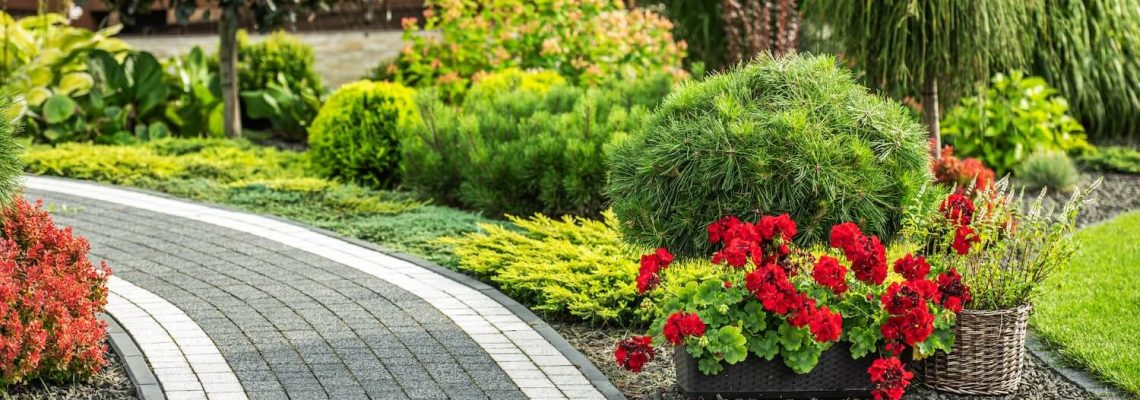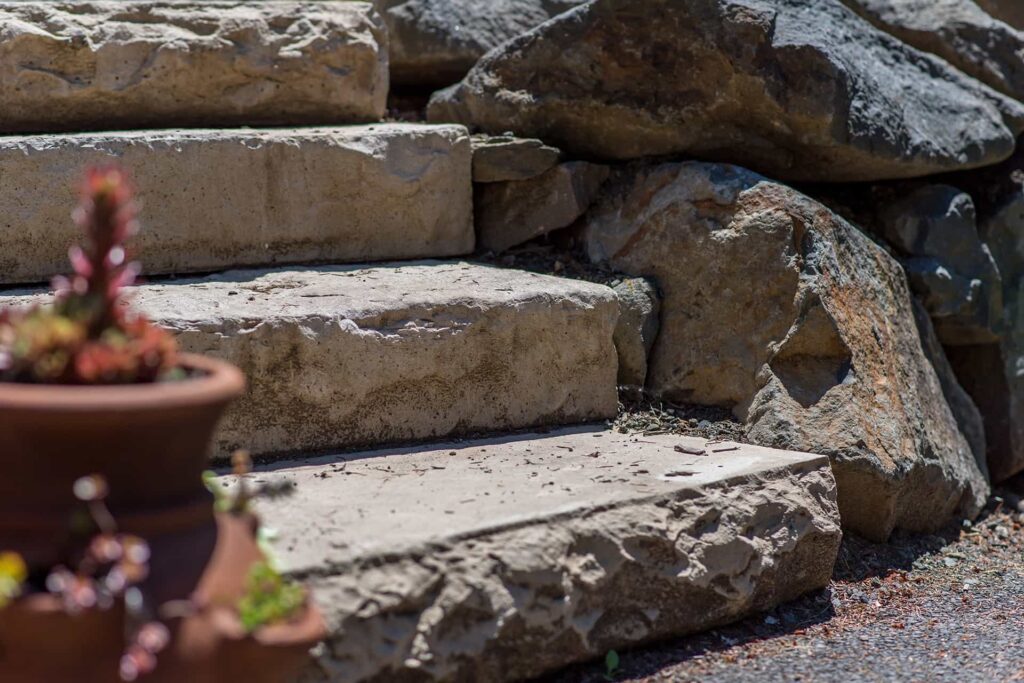Enhancing your home’s exterior often starts with a thoughtfully designed walkway. Walkways not only guide visitors through your property but also serve as an essential element of curb appeal. When deciding between paver walkways and concrete, homeowners must consider various factors, including aesthetics, durability, and maintenance. This article will delve into the benefits of paver walkways compared to concrete, making a compelling case for why pavers might be the perfect choice for your home.
1. Understanding Paver Walkways
What Are Outdoor Paver Walkways?
Paver walkways consist of individual units made from materials like concrete, brick, or natural stone. These units are laid out in various patterns, allowing for a highly customizable design. The variety of shapes, sizes, colors, and textures available means you can create a walkway that perfectly complements your landscape and enhances your home’s overall aesthetic.
Advantages of Paver Walkways in Landscape
Aesthetic Appeal
One of the most significant benefits of paver walkways is their stunning visual appeal. With a wide array of design options, homeowners can select pavers that reflect their unique style. Whether you prefer a contemporary look with sleek, modern pavers or a more traditional feel with natural stone, pavers elevate your property’s aesthetic. The ability to mix and match colors and patterns allows for endless creativity, ensuring that your walkway is not only functional but also a true work of art.
Durability and Longevity
Paver walkways are renowned for their durability, capable of withstanding heavy foot traffic and harsh weather conditions. When installed correctly, they can last for decades with minimal wear. If an individual paver becomes cracked or damaged, it can be easily replaced without the need to redo the entire walkway. This longevity makes pavers a smart investment, allowing you to enjoy their beauty and functionality for years to come.
Design Flexibility
Pavers offer unmatched flexibility in design. Homeowners can create intricate patterns, curves, and even personalized features that suit their landscape. This adaptability means you can achieve a unique and tailored look that enhances your outdoor space. The opportunity to incorporate borders, inlays, and other design elements allows you to create a walkway that is not only practical but also visually stunning.
Efficient Drainage
The design of paver walkways includes gaps between the units, promoting effective drainage. This feature helps prevent water pooling on the surface, reducing the risk of flooding and erosion. Proper drainage contributes to a healthier landscape, making pavers an environmentally friendly choice. By allowing rainwater to seep through, pavers help maintain the natural water cycle of your property, which can be particularly beneficial in areas prone to heavy rainfall.
Low Maintenance
Paver walkways require relatively low maintenance, especially compared to other materials. Regular sweeping and occasional hosing can keep them looking pristine. While sealing is recommended every few years to maintain their color and protect against stains, this process is straightforward and manageable. Unlike concrete, which may require extensive repairs or resurfacing, pavers provide a hassle-free option that lets you spend more time enjoying your outdoor space rather than maintaining it.
Disadvantages of Paver Walkways
Initial Cost
While the upfront cost of paver installation can be higher than that of concrete, it’s essential to view this as an investment in the long-term value of your home. The durability and aesthetic appeal of pavers can significantly enhance your property’s overall worth, making it a worthy consideration for homeowners looking to increase curb appeal.
Installation Complexity
The installation of paver walkways requires expertise and attention to detail. However, this complexity often results in a finished product that is truly unique and tailored to your specifications. Hiring a professional ensures that the installation is done correctly, resulting in a stunning walkway that you can be proud of for years to come.
2. Understanding Concrete Walkways
What Are Concrete Walkways?
Concrete walkways are created by pouring a mixture of cement, sand, gravel, and water into molds. Once set, the concrete forms a solid surface that can be stamped or stained for added aesthetic appeal. While concrete offers some design flexibility, it generally doesn’t provide the same level of customization as pavers.
Advantages of Concrete Walkways in Landscape
Cost-Effective
One of the primary advantages of concrete walkways is their affordability. The materials and labor required for installation are typically less expensive than those for paver walkways, making concrete an attractive option for budget-conscious homeowners. However, this initial cost saving can sometimes lead to a less visually appealing outcome compared to the vibrant and diverse options available with pavers.
Quick Installation
Concrete walkways can be poured and set relatively quickly, minimizing disruption to your landscaping. Typically, a concrete walkway can be completed in a day, which is appealing for those looking for immediate results. However, this speed does not always allow for the same level of customization and artistry that pavers provide.
Low Maintenance
Concrete walkways do require minimal maintenance, with regular cleaning and resealing every few years to maintain their appearance. However, addressing any cracks can be more challenging and may lead to more significant repair work over time. The seamless surface of concrete may not hide wear as well as individual pavers, which can lead to a less appealing look as time goes on.
Disadvantages of Concrete Walkways
Limited Design Options
While concrete can be stamped or stained, it generally offers fewer design options compared to pavers. Homeowners looking for unique patterns and textures may find concrete limiting. The customization possibilities are not as extensive, potentially leading to a more generic appearance that lacks the character of paver walkways.
Cracking and Repair Issues
Concrete is prone to cracking, especially in regions with extreme temperature fluctuations. Minor cracks can often be repaired, but significant damage may require extensive work. This potential for cracking can be a concern, particularly for homeowners who want a long-lasting, worry-free walkway.
Water Drainage Concerns
Unlike pavers, concrete walkways can create drainage issues if not properly graded. Without adequate drainage systems in place, water may pool on the surface, leading to erosion and potential damage over time. Homeowners must consider how their installation will interact with existing drainage patterns to avoid future complications.
3. Cost Comparison
When comparing the costs of paver walkways and concrete, it’s essential to consider both the initial investment and long-term maintenance expenses.
Paver Walkways
- Material Costs: Paver stones typically range from $3 to $10 per square foot, depending on the type and quality.
- Labor Costs: Installation costs can range from $6 to $12 per square foot, depending on the complexity of the design and local labor rates.
- Total Cost: The total cost for paver installation can range from $9 to $22 per square foot. While the initial investment is higher, the beauty, customization options, and longevity of pavers can significantly enhance your property’s value and appeal over time.
Concrete Walkways
- Material Costs: The cost of concrete is generally lower, averaging $2 to $6 per square foot.
- Labor Costs: Installation costs typically range from $3 to $8 per square foot.
- Total Cost: The total cost for concrete installation can range from $5 to $14 per square foot. Although concrete may seem more affordable initially, the aesthetic limitations and potential for cracking can impact long-term satisfaction.
While pavers may have a higher upfront cost, their durability, beauty, and low maintenance can provide exceptional value for your home.
4. Maintenance Considerations
Paver Walkways
Paver walkways generally require more attention than concrete but are well worth the effort. Maintenance includes:
- Regular Cleaning: Sweeping and hosing down the surface to remove dirt and debris, ensuring that the walkway looks its best.
- Weed Control: Keeping the joints free of weeds can be accomplished with regular maintenance, which is simple and effective. Using polymeric sand in the joints can also help minimize weed growth.
- Sealing: Periodically applying a sealant helps maintain color and protects against stains, ensuring that your pavers continue to shine.
Concrete Walkways
Concrete walkways are relatively low-maintenance but require some upkeep:
- Cleaning: Regular washing and sweeping to maintain cleanliness and prevent stains.
- Sealing: Resealing every 2 to 5 years helps protect the surface and maintain its appearance. However, if cracks appear, addressing them promptly can prevent more extensive repairs.
5. Aesthetic Considerations
Paver Walkways
The aesthetic possibilities with pavers are virtually limitless. Homeowners can create visually stunning walkways that enhance the beauty of their homes. With the option to incorporate intricate designs, different textures, and vibrant colors, pavers offer a unique opportunity to reflect your personal style and elevate your landscape.
Concrete Walkways
Concrete, while functional, generally lacks the customization and visual appeal offered by pavers. Though stamped and stained concrete can imitate other materials, it often doesn’t achieve the same depth of color or texture. For homeowners seeking a distinctive look that truly stands out, pavers are an obvious choice.
6. Installation Process
Paver Walkways
The installation of paver walkways involves several steps that ultimately lead to a beautiful and customized end result:
- Planning: Design the layout, including curves and patterns, ensuring the perfect fit for your landscape.
- Excavation: Remove existing soil and vegetation to create a stable base for the walkway.
- Base Layer: Install a compacted base layer of gravel or sand to provide stability and promote drainage.
- Laying Pavers: Arrange the pavers according to the design, ensuring proper spacing and alignment to create a visually appealing pattern.
- Joint Sand: Fill the joints with sand to hold the pavers in place and prevent shifting, ensuring durability.
- Sealing: Apply a sealant to protect the pavers from stains and fading, maintaining their vibrant appearance for years.
Concrete Walkways
The installation of concrete walkways involves a simpler process, but with limitations:
- Planning: Design the layout and ensure proper measurements for the mold.
- Excavation: Remove existing soil and vegetation to create a stable base.
- Mold Setup: Set up molds or forms to contain the concrete during pouring, which can limit creativity.
- Pouring Concrete: Mix and pour the concrete into the molds, spreading it evenly, but resulting in a more uniform surface.
- Finishing: Smooth the surface and create texture if desired, which often cannot match the diversity of pavers.
- Curing: Allow the concrete to cure for the recommended time, during which the walkway may lack accessibility.
7. Making the Decision
Ultimately, the choice between paver walkways and concrete should align with your specific needs, preferences, and budget. Consider the following factors:
- Aesthetic Goals: If you prioritize design and customization, pavers are the clear choice, offering a myriad of options to enhance your property’s appearance.
- Budget Constraints: While concrete may appear cost-effective initially, consider the long-term value pavers provide through increased curb appeal and property value.
- Maintenance Willingness: If you prefer a low-maintenance option, concrete may seem appealing. However, the longevity and beauty of pavers with proper maintenance can be more rewarding.
- Long-Term Value: Pavers may have a higher upfront cost, but their aesthetic appeal and durability can enhance your property’s value over time, making them a smart investment.
Conclusion
In conclusion, while both paver walkways and concrete offer unique advantages and disadvantages, paver walkways emerge as the superior choice for homeowners seeking to enhance their property’s beauty and functionality. With stunning aesthetic possibilities, unmatched durability, and low maintenance requirements, pavers are a worthwhile investment that can elevate your home’s exterior and create a welcoming atmosphere for guests. By opting for the elegance and versatility of pavers, you can enjoy a beautiful walkway that complements your landscape and stands the test of time. Choose pavers, and transform your outdoor space into a stunning pathway that reflects your style and enhances your home’s value.


